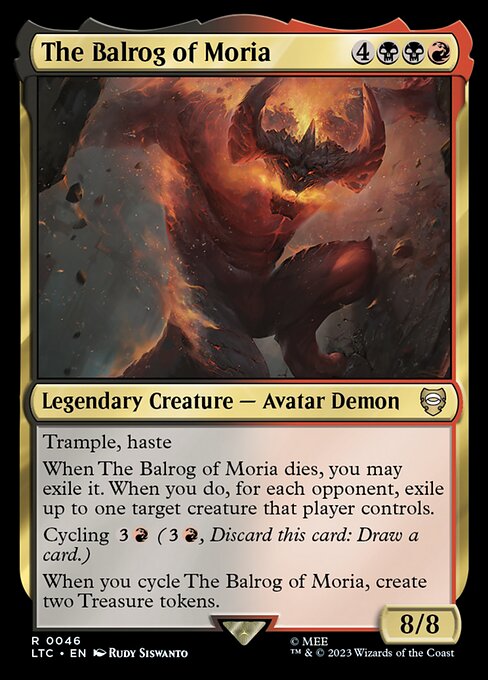
Image courtesy of Scryfall.com
Color Palette and Symbolism in MTG
Two colors blaze at the heart of this legendary creature—black and red—reflecting a marriage of shadowy ambition and unbound fervor. The Balrog of Moria, a rare from the Tales of Middle-earth Commander set, carries a mana cost of 4BBR and a towering 8/8 body with trample and haste. The card’s identity and abilities are a study in how color choices shape strategy, flavor, and the tempo of a match 🧙♂️🔥. In many ways, its design is a microcosm of the larger MTG metagame: raw power, risky play, and inevitable consequences that ripple across the battlefield.
Two Colors, One Fiery Soul
Black and red together conjure a spectrum of themes: power, curses, pushing through threats, and a willingness to flirt with danger to achieve a bigger payoff. Black draws on resilience, resourceful manipulation, and mortality as a lever for control, while red brings speed, aggression, and catalytic chaos. The Balrog embodies that clash: a staggering 8/8 with haste means you deploy it to crater the opponent’s board presence in short order, then pressure the table with a relentless, fire-wueled assault. The dual-color identity also invites you to build around a mana base that can reliably ramp into its {4}{B}{B}{R} cost while maximizing color-synergy cards in both black and red shards 🧙♂️⚔️.
Power, Resilience, and a Lethal Exit Strategy
Beyond its raw stats, the Balrog’s text tells a story of a creature that can shape the game even after it leaves the battlefield. When it dies, you may exile it. If you do, for each opponent, exile up to one target creature that player controls. That’s a dramatic, multi-player reset that can swing momentum back in your favor—and it’s only one step away from a devastating board wipe in the right context. This is where the card’s lore-tinged design shines: a Balrog falling back into the shadows to rearrange the battlefield mirrors the ancient myth that power inevitable corrupts and disperses in unpredictable ways 🧙♂️🔥.
Cycling and Treasure: A Red-Hired Ramp Engine
One of the Balrog’s most provocative lines is its cycling ability: {3}{R} to discard and draw a card. When you cycle this card, you don’t just refresh your hand—you generate two Treasure tokens. In Commander and other multiplayer formats, Treasure is both mana acceleration and a narrative cue: it’s the literal glow of looted gold powering your next turn, your next big spell, or your next explosive attack. This creates a classic “risk-reward” loop: you may pay the cycling cost to fuel card draw and temporary advantage, yet you’re also building a resource engine that can outpace slower decks as the game progresses 💎🎲. It’s a design that invites aggressive, tempo-forward play or a midgame pivot into a treasure-slinging late-game threat.
Flavor, Lore, and the Art Direction
The Balrog of Moria stands proudly within the lore-adjacent space of MTG’s Middle-earth crossover. The creature type “Avatar Demon” and the pairing of black and red echo the Balrog’s fiery, shadow-haunted presence from Tolkien’s legendarium. The art by Rudy Siswanto complements the dual-nature identity: a figure of blazing inferno punctured by obsidian shadows, a visual metaphor for a being that is at once wrathful and ancient. The illustration, the frame, and the card’s rare status in a Commander set all contribute to a collectible experience that resonates with nostalgia while still delivering modern gameplay hooks 🔥🎨.
Strategic Footnotes for Commander Players
In a busy Commander table, The Balrog of Moria serves as a high-impact threat that demands immediate attention. Its trample allows you to push damage through even when blockers loom, while haste ensures you don’t wait a turn to threaten an endgame swing. The “dies, exile-target-creature” clause can disrupt opponents’ boards by forcing each player to exile their own creatures, potentially removing large attackers or blockers in the same moment that you collapse their defenses. Coupled with Cycling to spawn Treasure tokens, the Balrog earns a position as both a finisher and a ramp engine—especially in builds that lean into treasure synergies, red spell bombardments, and graveyard interactions. The risk, of course, is vulnerability to removal—this is a classic high-reward target. If you invest in protection and ways to recur or reanimate, you can leverage the card’s powerful last-flare into a lasting victory 🧙♂️💎.
Design Notes: What It Says About MTG’s Color Theory
Cards like The Balrog of Moria demonstrate how MTG designers lean on color identity to sculpt complex decision trees. Black-red hybrids channel the thrill of risk and reward: you’re rewarded for pushing your limits and paying costs later. The cycling-to-Treasure mechanic embodies red’s love of velocity and improvisation, turning a mere draw into a scalable resource engine. The death-trigger exile for opponents’ creatures adds a form of “revenge” that rewards aggressive, board-controlling playstyles. It’s a flavorful package—gory yet strategic, mythic yet practical—that proves color-pairing can be both narrative and mechanically satisfying 🧙♂️🔥💎.
If you’re curious to explore more MTG gear while you map out your next Balrog-inspired deck, consider a modern, sleek accessory that fits your devices and style. The featured product below offers a nimble way to carry your day-to-day tech with flair—and it’s a playful nod to the legendary intensity of this card’s color-saturated world.
Slim Glossy Phone Case for iPhone 16 (Lexan PC)
More from our network
- https://blog.digital-vault.xyz/blog/post/blue-hot-stellar-motion-reconstructed-from-pmra-and-pmdec-at-28-kiloparsecs/
- https://blog.digital-vault.xyz/blog/post/crafting-digital-business-card-templates-for-consistent-branding/
- https://transparent-paper.shop/blog/post/how-to-create-custom-digital-stickers-for-goodnotes-a-quick-guide/
- https://crypto-acolytes.xyz/blog/post/blue-white-giant-maps-galactic-structure-in-sagittarius/
- https://blog.crypto-articles.xyz/blog/post/from-hollywood-to-horticulture-a-list-star-champions-seed-saving/